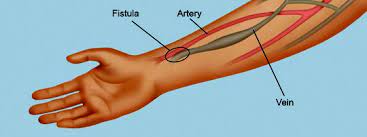
DIALYSIS ACCESS
Dialysis access refers to the method by which blood is removed from the body and filtered during hemodialysis, a medical treatment used to remove excess waste and fluid from the blood of people whose kidneys are not functioning properly.
Introduction:
DIALYSIS ACCESS There are several types of dialysis access, including arteriovenous fistulas, arteriovenous grafts, and central venous catheters. The type of access used will depend on the individual patient’s needs and circumstances. It is important to maintain and care for dialysis access properly to ensure the effectiveness and safety of the dialysis treatment.
What Is DIALYSIS ACCESS:
Dialysis access is a method of connecting the blood vessels in the body to the dialysis machine, which is used to filter the blood during hemodialysis. Hemodialysis is a medical treatment used to remove excess waste and fluid from the blood of people whose kidneys are not functioning properly. Dialysis access allows the blood to be removed from the body, filtered by the dialysis machine, and returned to the body. There are several types of dialysis access, including arteriovenous fistulas, arteriovenous grafts, and central venous catheters. The type of access used will depend on the individual patient’s needs and circumstances. It is important to maintain and care for the dialysis access properly to ensure the effectiveness and safety of the dialysis treatment.
What Is The Procedure Of DIALYSIS ACCESS:
The procedure for establishing dialysis access will depend on the type of access being used. Here is a general overview of the process for each type of dialysis access:
- Arteriovenous fistulas: An arteriovenous fistula is created by connecting an artery and a vein surgically, usually in the arm. The procedure is typically performed a few months before starting dialysis to allow the fistula to mature. The surgery is done under local anesthesia and usually takes about an hour.
- Arteriovenous grafts: An arteriovenous graft is created by using a synthetic tube to connect an artery and a vein, usually in the arm. The procedure is similar to creating an arteriovenous fistula and is also typically performed a few months before starting dialysis.
- Central venous catheters: A central venous catheter is a long, thin tube that is inserted into a large vein in the neck, chest, or groin. The procedure is usually done in a hospital and is typically performed when a patient needs to start dialysis immediately and there is not enough time to create an arteriovenous fistula or graft.
It is important to follow the care instructions provided by the healthcare team to maintain and care for the dialysis access properly. This will help ensure the effectiveness and safety of the dialysis treatment.

If you want to get amazing benefits by using this link
Genetics For Testing Personal Health
DIALYSIS ACCESS Conclusion:
Dialysis access is a critical aspect of hemodialysis, a medical treatment used to remove excess waste and fluid from the blood of people whose kidneys are not functioning properly. There are several types of dialysis access, including arteriovenous fistulas, arteriovenous grafts, and central venous catheters. The type of access used will depend on the individual patient’s needs and circumstances. The procedure for establishing dialysis access will vary depending on the type of access being used. It is important to follow the care instructions provided by the healthcare team to maintain and care for the dialysis access properly to ensure the effectiveness and safety of the dialysis treatment.




